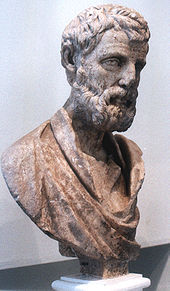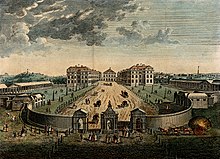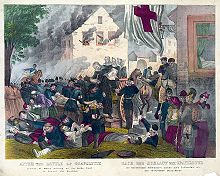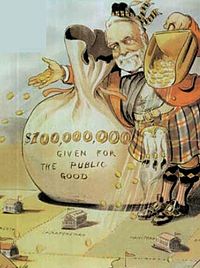Philanthropy
Philanthropy is a form of altruism that consists of "private initiatives for the public good, focusing on quality of life".[1] Philanthropy contrasts with business initiatives, which are private initiatives for private good, focusing on material gain; and with government endeavors that are public initiatives for public good, such as those that focus on the provision of public services.[1] A person who practices philanthropy is a philanthropist.
Etymology

The word philanthropy comes from
During the Middle Ages, philanthrôpía was superseded in Europe by the Christian virtue of charity (Latin: caritas) in the sense of selfless love, valued for salvation and escape from purgatory.[3] Thomas Aquinas held that "the habit of charity extends not only to the love of God, but also to the love of our neighbor".[4]
Sir
Europe
Great Britain

In London, prior to the 18th century, parochial and civic charities were typically established by bequests and operated by local church parishes (such as
In 1739, Thomas Coram, appalled by the number of abandoned children living on the streets of London, received a royal charter to establish the Foundling Hospital to look after these unwanted orphans in Lamb's Conduit Fields, Bloomsbury.[8] This was "the first children's charity in the country, and one that 'set the pattern for incorporated associational charities' in general."[8] The hospital "marked the first great milestone in the creation of these new-style charities."[7]
19th century
Philanthropists, such as
Financial donations to organized charities became fashionable among the middle class in the 19th century. By 1869 there were over 200 London charities with an annual income, all together, of about £2 million. By 1885, rapid growth had produced over 1000 London charities, with an income of about £4.5 million. They included a wide range of religious and secular goals, with the American import, YMCA, as one of the largest, and many small ones, such as the Metropolitan Drinking Fountain Association. In addition to making annual donations, increasingly wealthy industrialists and financiers left generous sums in their wills. A sample of 466 wills in the 1890s revealed a total wealth of £76 million, of which £20 million was bequeathed to charities. By 1900 London charities enjoyed an annual income of about £8.5 million.[12]: 125
Led by the energetic
Switzerland

In 1863, the Swiss businessman Henry Dunant used his fortune to fund the Geneva Society for Public Welfare, which became the International Committee of the Red Cross. During the Franco-Prussian War of 1870, Dunant personally led Red Cross delegations that treated soldiers. He shared the first Nobel Peace Prize for this work in 1901.[15]
The International Committee of the Red Cross (ICRC) played a major role in working with POWs on all sides in World War II. It was in a cash-starved position when the war began in 1939, but quickly mobilized its national offices to set up a Central Prisoner of War Agency. For example, it provided food, mail and assistance to 365,000 British and Commonwealth soldiers and civilians held captive. Suspicions, especially by London, of ICRC as too tolerant or even complicit with Nazi Germany led to its side-lining in favour of the UN Relief and Rehabilitation Administration (UNRRA) as the primary humanitarian agency after 1945.[16]
France

The French Red Cross played a minor role in the war with Germany (1870–71). After that, it became a major factor in shaping French civil society as a non-religious humanitarian organization. It was closely tied to the army's Service de Santé. By 1914 it operated one thousand local committees with 164,000 members, 21,500 trained nurses, and over 27 million French francs in assets.[17]
The Pasteur Institute had a monopoly of specialized microbiological knowledge, allowing it to raise money for serum production from private and public sources, walking the line between a commercial pharmaceutical venture and a philanthropic enterprise.[18]
By 1933, at the depth of the
American money proved invaluable. The Rockefeller Foundation opened an office in Paris and helped design and fund France's modern public health system under the National Institute of Hygiene. It also set up schools to train physicians and nurses.[20]
Germany
The history of modern philanthropy on the European continent is especially important in the case of Germany, which became a model for others, especially regarding the
Religion was divisive in Germany, as Protestants, Catholics, and Jews used alternative philanthropic strategies. The Catholics, for example, continued their medieval practice of using financial donations in their wills to lighten their punishment in purgatory after death. The Protestants did not believe in purgatory, but made a strong commitment to improving their communities there and then. Conservative Protestants raised concerns about deviant sexuality, alcoholism, and socialism, as well as illegitimate births. They used philanthropy to try to eradicate what they considered as "social evils" that were seen as utterly sinful.[22] All the religious groups used financial endowments, which multiplied in number and wealth as Germany grew richer. Each was devoted to a specific benefit to that religious community, and each had a board of trustees; laymen donated their time to public service.
Chancellor
The heavy human and economic losses of the
War and postwar: Belgium and Eastern Europe

The Commission for Relief in Belgium (CRB) was an international (predominantly American) organization that arranged for the supply of food to German-occupied Belgium and northern France during the First World War. It was led by Herbert Hoover.[24] Between 1914 and 1919, the CRB operated entirely with voluntary efforts and was able to feed eleven million Belgians by raising money, obtaining voluntary contributions of money and food, shipping the food to Belgium and controlling it there. For example, the CRB shipped 697,116,000 pounds of flour to Belgium.[25]: 72–95 Biographer George Nash finds that by the end of 1916, Hoover "stood preeminent in the greatest humanitarian undertaking the world had ever seen."[26] Biographer William Leuchtenburg adds, "He had raised and spent millions of dollars, with trifling overhead and not a penny lost to fraud. At its peak, his organization fed nine million Belgians and French daily.[27]: 30
When the war ended in late 1918, Hoover took control of the American Relief Administration (ARA), with the mission of food[clarification needed] to Central and Eastern Europe. The ARA fed millions.[25]: 114–137 U.S. government funding for the ARA expired in the summer of 1919, and Hoover transformed the ARA into a private organization, raising millions of dollars from private donors. Under the auspices of the ARA, the European Children's Fund fed millions of starving children. When attacked for distributing food to Russia, which was under Bolshevik control, Hoover snapped, "Twenty million people are starving. Whatever their politics, they shall be fed!"[27]: 58 [28]
United States
The first corporation founded in the Thirteen Colonies was Harvard College (1636), designed primarily to train young men for the clergy. A leading theorist was the Puritan theologian Cotton Mather (1662–1728), who in 1710 published a widely read essay, Bonifacius, or an Essay to Do Good. Mather worried that the[specify] original idealism had eroded, so he advocated philanthropic benefaction as a way of life. Though his context was Christian, his idea was also characteristically American and explicitly Classical[specify], on the threshold of the Enlightenment.[29]
Benjamin Franklin (1706–1790) was an activist and theorist of American philanthropy. He was much influenced by Daniel Defoe's An Essay upon Projects (1697) and Cotton Mather's Bonifacius: an essay upon the good (1710). Franklin attempted to motivate his fellow Philadelphians into projects for the betterment of the city: examples included the Library Company of Philadelphia (the first American subscription library), the fire department, the police force, street lighting, and a hospital. A world-class physicist himself, he promoted scientific organizations including the Philadelphia Academy (1751) – which became the University of Pennsylvania – as well as the American Philosophical Society (1743), to enable scientific researchers from all 13 colonies to communicate.[30]
By the 1820s, newly rich American businessmen were initiating philanthropic work, especially with respect to private colleges and hospitals. George Peabody (1795–1869) is the acknowledged[by whom?] father of modern philanthropy. A financier based in Baltimore and London, in the 1860s, he began to endow libraries and museums in the United States and also funded housing for poor people in London. His activities became a model for Andrew Carnegie and many others.[31]
Andrew Carnegie

Andrew Carnegie (1835–1919) was the most influential leader of philanthropy on a national (rather than local) scale. After selling his steel company in 1901 he devoted himself to establishing philanthropic organizations and to making direct contributions to many educational, cultural, and research institutions. He financed over 2,500 public libraries built across the United States and abroad. He also funded Carnegie Hall in New York City and the Peace Palace in the Netherlands.
His final and largest project was the Carnegie Corporation of New York, founded in 1911 with a US$25 million endowment, later enlarged to US$135 million. Carnegie Corporation has endowed or otherwise helped to establish institutions that include the Russian Research Center at Harvard University (now known as the Davis Center for Russian and Eurasian Studies), the Brookings Institution and the Sesame Workshop. In all, Andrew Carnegie gave away 90% of his fortune.[32]
John D. Rockefeller

Other prominent American philanthropists of the early 20th century included John D. Rockefeller (1839–1937), Julius Rosenwald (1862–1932)[33] and Margaret Olivia Slocum Sage (1828–1918).[34]
Rockefeller retired from business in the 1890s; he and his son John D. Rockefeller Jr. (1874–1960) made large-scale national philanthropy systematic, especially with regard to the study and application of modern medicine, higher education, and scientific research. Of the US$530 million the elder Rockefeller gave away, US$450 million went to medicine.[35] Their leading advisor Frederick Taylor Gates launched several large philanthropic projects staffed by experts who sought to address problems systematically at the roots rather than let the recipients deal only with their immediate concerns.[36]
By 1920, the Rockefeller Foundation was opening offices in Europe. It launched medical and scientific projects in Britain, France, Germany, Spain, and elsewhere. It supported the health projects of the League of Nations.[37] By the 1950s, it was investing heavily in the Green Revolution, especially the work by Norman Borlaug that enabled India, Mexico, and many poor countries to upgrade their agricultural productivity dramatically.[38]
Ford Foundation
With the acquisition of most of the stock of the Ford Motor Company in the late 1940s, the Ford Foundation became the largest American philanthropy, splitting its activities between the United States and the rest of the world. Outside the United States, it established a network of human rights organizations, promoted democracy, gave large numbers of fellowships for young leaders to study in the United States, and invested heavily in the Green Revolution, whereby poor nations dramatically increased their output of rice, wheat, and other foods. Both Ford and Rockefeller were heavily involved.[39] Ford also gave heavily to build up research universities in Europe and worldwide. For example, in Italy in 1950, sent a team to help the Italian ministry of education reform the nation's school system, based on meritocracy (rather than political or family patronage) and democratisation (with universal access to secondary schools). It reached a compromise between the Christian Democrats and the Socialists to help promote uniform treatment and equal outcomes. The success in Italy became a model for Ford programs and many other nations.[40]
The Ford Foundation in the 1950s wanted to modernize the legal systems in India and Africa, by promoting the American model. The plan failed, because of India's unique legal history, traditions, and profession[clarification needed], as well as its economic and political conditions. Ford, therefore, turned to agricultural reform.[41] The success rate in Africa was no better, and that program closed in 1977.[42]
Asia
While charity has a long history in Asia, as of 2018[update] philanthropy or a systematic approach to doing good remains nascent.[43] Chinese philosopher Mozi (c. 470 – c. 391 BCE) developed the concept of "universal love" (jiān'ài, 兼愛), a reaction against perceived over-attachment to family and clan structures within Confucianism. Other interpretations of Confucianism see concern for others as an extension of benevolence.[44]
Muslims in countries such as Indonesia are bound by zakat (almsgiving), while Buddhists and Christians throughout Asia may participate in philanthropic activities. In India, corporate social responsibility (CSR) is now mandated, with 2% of net profits to be directed towards charity.[45]
Asia is home to most of the world's billionaires, surpassing the United States and Europe in 2017.[46] Wikipedia's list of countries by number of billionaires shows four Asian economies in the top ten: 495 in China, 169 in India, 66 in Hong Kong, and 52 in Taiwan (as of April 2023[update]).
While the region's philanthropy practices are relatively under-researched compared to those of the United States and Europe, the Centre for Asian Philanthropy and Society (CAPS) produces a study of the sector every two years. In 2020, its research found that if Asia were to donate the equivalent of two percent of its GDP, the same as the United States, it would unleash US$507 billion (HK$3.9 trillion) annually, more than 11 times the foreign aid flowing into the region every year and one-third of the annual amount needed globally to meet the sustainable development goals by 2030.[47]
Oceania
Australia
Structured giving in Australia through foundations[48] is slowly growing, although public data on the philanthropic sector is sparse.[49] There is no public registry of philanthropic foundations as distinct from charities more generally.
Two foundation types for which some data is available[50][51] are Private Ancillary Funds (PAFs)[52] and Public Ancillary Funds (PubAFs).[53] Private Ancillary Funds have some similarities to private family foundations in the US and Europe, and do not have a public fundraising requirement.[54] Public Ancillary Funds include community foundations, some corporate foundations, and foundations that solely support single organisations such as hospitals, schools, museums, and art galleries.[55] They must raise funds from the general public.[56]
Differences between traditional and new philanthropy
Impact investment versus traditional philanthropy
Traditional philanthropy and
A suggested explanation for the preference for impact investment philanthropy to traditional philanthropy is the gaining prominence of the Sustainable Development Goals (SDGs) since 2015. Almost every SDG is linked to environmental protection and sustainability because of rising concerns about how globalisation, consumerism, and population growth may affect the environment. As a result, development agencies have seen increased demands for accountability as they face greater pressure to fit with current developmental agendas.
Traditional philanthropy versus philanthrocapitalism
Philanthrocapitalism differs from traditional philanthropy in how it operates. Traditional philanthropy is about charity, mercy, and selfless devotion improving recipients' wellbeing.[58] Philanthrocapitalism, is philanthropy transformed by business and the market,[59] where profit-oriented business models are designed that work for the good of humanity.[60] Share value companies are an example. They help develop and deliver curricula in education, strengthen their own businesses and improve the job prospects of people.[61] Firms improve social outcomes, but while they do so, they also benefit themselves.
The rise of philanthrocapitalism can be attributed to global
Intel invests in science, technology, engineering, and mathematics (STEM) curricular standards in the US and provides learning resources and materials for schools, for its innovation and revenue.[62] The New Employment Opportunities initiative in Latin America is a regional collaboration to train one million youth by 2022 to raise employment standards and ultimately provide a talented pool of labour for companies.
Promoting equity through science and health philanthropy
Philanthropy has the potential to foster equity and inclusivity in various fields, such as scientific research, development, and healthcare. Addressing systemic inequalities in these sectors can lead to more diverse perspectives, innovations, and better overall outcomes.
Scholars have examined the importance of philanthropic support in promoting equity in different areas. For example, Christopherson et al.
To advance equity in science and healthcare, philanthropists can adopt several key strategies:
- Prioritize underrepresented groups: Support scientists and health professionals from diverse backgrounds to help address historical injustices and foster diversity.
- Encourage equitable partnerships: Facilitate collaborations between institutions from different backgrounds to promote knowledge exchangeand a fair distribution of resources.
- Advocate for diverse leadership: Support initiatives that emphasize diversity and inclusion in leadership positions within scientific and health institutions.
- Invest in early-career professionals: Help create a more equitable pipeline for future leaders in science and healthcare by investing in early-career researchers and health professionals.
- Influence policy changes: Utilize philanthropic influence to advocate for policy changes that address systemic inequalities in science and health.
Through these approaches, philanthropy can significantly promote equity within scientific and health communities, leading to more inclusive and effective advancements.
Types of philanthropy
Philanthropy is defined differently by different groups of people; many define it as a means to alleviate human suffering and advance the quality of life.[67] There are many forms of philanthropy, allowing for different impacts by different groups in different settings.
Celebrity philanthropy
Celebrity philanthropy refers to
This is sometimes termed as "celanthropy"—the fusion of celebrity and cause as a representation of what the organisation advocates.[68]: 5
Implications on government and governance
The advent of celebrity philanthropy has coincided with the contraction of government involvement in areas such as
Examples
- The Concert for Bangladesh
- Band Aid
- LiveAid
- NetAid
- Danny Thomas and St. Jude Children's Research Hospital
- Geena Davis Institute on Gender in Media
- Jerry Lewis and the MDA Telethon
- List of UNICEF Goodwill Ambassadors
- Newman's Own
- Tiger Woods Foundation
- Richard Gere Activism
- Remote Area Medical
Diaspora philanthropy
Diaspora philanthropy is philanthropy conducted by diaspora populations either in their country of residence or in their countries of origin. Diaspora philanthropy is a newly established term with many variations, including migrant philanthropy, homeland philanthropy, and transnational giving.[70] In diaspora philanthropy, migrants and their descendants are frontline distributors of aid, and enablers of development.[71] For many countries, diaspora philanthropy is a prominent way in which members of the diaspora invest back into their homeland countries.
Along with diaspora-led foreign direct investment, diaspora philanthropy is a force in the development of a country. Members of a diaspora are familiar with their community's needs and the social, political, and economic factors that influence the delivery of those needs. Studies show that those who are a part of the diaspora are more aware of the pressing and neglected issues of their community than outsiders or other well wishers.[72] Also given their deep ties to their country of origin, diaspora philanthropies have greater longevity than other international philanthropies. Due to the distance buffer accompanied with[clarification needed] diaspora philanthropy, diaspora philanthropy is more willing to address controversial issues found in their country of origin compared to local philanthropy.[70]
Philanthropic capitalism
This section may be in need of reorganization to comply with Wikipedia's layout guidelines. The reason given is: merge into "Traditional philanthropy versus philanthrocapitalism" above. (August 2023) |
Criticism
Philanthropy has been used by
The ability of wealthy people to deduct a significant amount of their tax liabilities in the form of philanthropic giving, as noted by the late German billionaire shipping magnate and philanthropist Peter Kramer, functioned as "a bad transfer of power", from democratically elected politicians to unelected billionaires, whereby it is no longer "the state that determines what is good for the people, but rather the rich who decide". The Global Policy Forum, an independent policy watchdog which functions to monitor the activities of the United Nations General Assembly, warned governments and international organisations that they should "assess the growing influence of major philanthropic foundations, and especially the Bill & Melinda Gates Foundation… and analyse the intended and unintended risks and side-effects of their activities" prior to accepting money from rich donors. In 2015, Global Policy Forum also warned elected politicians that they should be particularly concerned about "the unpredictable and insufficient financing of public goods, the lack of monitoring and accountability mechanisms, and the prevailing practice of applying business logic to the provision of public goods".[76]
Giridharadas also argues that philanthropy distracts the public from some of the ill-gotten gains that were derived via profit. For example, the Sackler family were known for their generous philanthropic giving to various cultural institutions worldwide. However, their philanthropic giving functioned as deception and propaganda, as their legacy of generosity was tainted by the subsequent exposure of Purdue Pharma's role in encouraging and exacerbating the opioid epidemic.[77] As a result of their exposed ill-gotten gains from the social issues caused by the philanthropic donors, the British institutions of the National Portrait Gallery, London and the Tate, along with the American institution Solomon R. Guggenheim Museum, announced their rejection of charitable giving from the Sackler family trusts.[77]
See also
- List of philanthropists
- List of wealthiest charitable foundations
- Charitable organization – Nonprofit organization with charitable purpose
- Effective altruism – Philosophical and social movement
- Ethics of philanthropy – Ethical issues specific to philanthropy
- Foundation (charity)– Type of nonprofit organization
- Non-profit organization– Organization operated for a collective benefit
- Philanthropic capitalism – Method of philanthropy that mirrors a for-profit business
- Venture philanthropy – Investment
- Visiting the sick – Philanthropic practice
References
- ^ ISBN 978-1438905617.
- ^ "Philanthropy". Online Etymology Dictionary.
- ^ Aquinas, Thomas. "Charity, considered in itself". Summa Theologiae. Secunda Secundae Partis, Q. 23.
- ^ Aquinas, Thomas. "The object of charity". Summa Theologiae. Secunda Secundae Partis, Q. 25.
- ^ Johnson, Samuel (1755). "Philanthropy". A Dictionary of the English Language. Vol. I. London.
- ^ Kutney, Mitchell (2013-06-18). "Philanthropy is what sustains the charitable sector, not money". Blue & Green Tomorrow. Retrieved 2014-11-08.
- ^ a b "Associational Charities". London Lives. Retrieved 29 January 2016.
- ^ a b Banerjee, Jacqueline. "Captain Coram and the Foundling Hospital". The Victorian Web. Retrieved 29 January 2016.
- ISBN 978-0-393-32847-9.
- S2CID 150275678.
- S2CID 159547077.
- ^ ISBN 0582089212.
- ^ Finlayson, Geoffrey (March 1983). "The Victorian Shaftesbury". History Today. 33 (3): 31–35.
- ISBN 978-0521085069.
